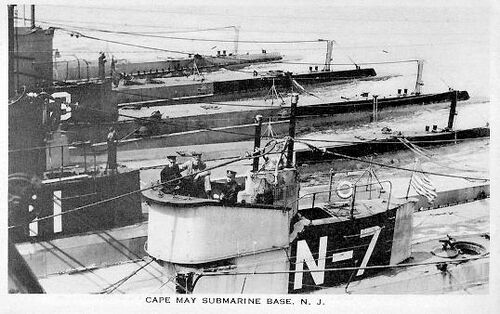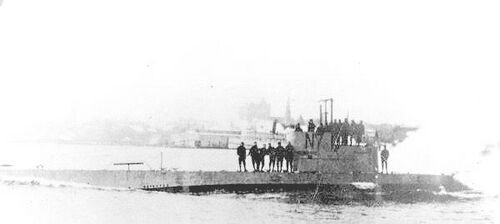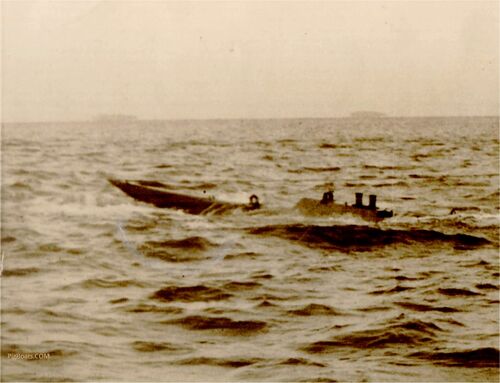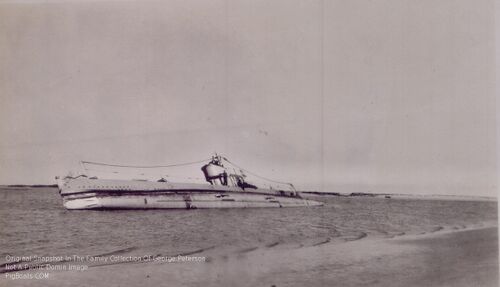N-7: Difference between revisions
Pbcjohnston (talk | contribs) Added captions |
Pbcjohnston (talk | contribs) Updated text |
||
| Line 18: | Line 18: | ||
N-7 diving in Long Island Sound in December 1918. The N-7 had undergone a wartime upkeep at the Brooklyn Navy Shipyard in September and October 1918. With the World War One ending in November 1918 the N-7 resumed training exercises out of New London, Connecticut. | N-7 diving in Long Island Sound in December 1918. The N-7 had undergone a wartime upkeep at the Brooklyn Navy Shipyard in September and October 1918. With the World War One ending in November 1918 the N-7 resumed training exercises out of New London, Connecticut. | ||
She is seen here diving in the Sound with what is assumed to be the Connecticut coastline in the background. The N-7 was plagued with design problems and only spent 4 years in commission. | She is seen here diving in the Sound with what is assumed to be the Connecticut coastline in the background. This is an unusual diving angle for a Lake built submarine, as Lake's design emphasized zero-angle diving utilizing his patented midships diving planes. Zero-angle diving (aka "even-keel diving") was a problematic concept. It never really worked the way that Lake envisioned, as even a minor imbalance in fore to aft trim would cause the boat to take an angle. There was also a design issue with the diving planes being too close to the pivot point of the boat's longitudinal plane, rendering them far less effective in canceling out problems in trim. | ||
The N-7 was plagued with design and mechanical problems and only spent 4 years in commission. | |||
<small>Photo in the private collection of Ric Hedman</small> | <small>Photo in the private collection of Ric Hedman</small> | ||
| Line 25: | Line 27: | ||
[[File:N-7 diving long island-2.jpg|left|500px]] | [[File:N-7 diving long island-2.jpg|left|500px]] | ||
Closeup of the photo above, showing the conning tower fairwater as the N-7 dives into Long Island Sound. The sub's identification can just be seen on the fairwater as it slides downward. The #2 periscope is raised | Closeup of the photo above, showing the conning tower fairwater as the N-7 dives into Long Island Sound. The sub's identification can just be seen on the fairwater as it slides downward. The #2 periscope is raised. | ||
<small>Photo in the private collection of Ric Hedman</small> | <small>Photo in the private collection of Ric Hedman</small> | ||
| Line 41: | Line 43: | ||
N-7 aground at some location off the Atlantic shore in the early 1920's. The N-7 had a brief history. A lot of Lake submarines suffered from poor design, workmanship, and reliability. In all the N-7 spent 4 years in commission with an upkeep and an extensive overhaul of almost a year at Philadelphia Navy Yard. | N-7 aground at some location off the Atlantic shore in the early 1920's. The N-7 had a brief history. A lot of Lake submarines suffered from poor design, workmanship, and reliability. In all the N-7 spent 4 years in commission with an upkeep and an extensive overhaul of almost a year at Philadelphia Navy Yard. | ||
Where the N-7 has run aground isn't | Where the N-7 has run aground isn't recorded in her [https://www.history.navy.mil/research/histories/ship-histories/danfs/n/n-7.html '''Dictionary of American Naval Fighting Ships'''] entry. This was possibly while she was under tow to eventual decommissioning in Philadelphia, early 1922. | ||
The crew is sitting and standing on the deck and the bridge. | The crew is sitting and standing on the deck and the bridge. One of her midships diving planes can be seen just below the standing man and another further aft on the hull. The shutter doors for the torpedo tubes can be seen at the bow. | ||
<small>Original snapshot in the private family collection Of George Peterson. Used with permission. MAY NOT be reused or reposted without permission.</small> | <small>Original snapshot in the private family collection Of George Peterson. Used with permission. MAY NOT be reused or reposted without permission.</small> | ||
Revision as of 12:39, 28 July 2024

Photo in the private collection of Ric Hedman

N-7 underway, possibly in the East River off New York City following an upkeep at the Brooklyn Navy Yard, September 1918.
Photo in the private collection of Ric Hedman

N-7 diving in Long Island Sound in December 1918. The N-7 had undergone a wartime upkeep at the Brooklyn Navy Shipyard in September and October 1918. With the World War One ending in November 1918 the N-7 resumed training exercises out of New London, Connecticut.
She is seen here diving in the Sound with what is assumed to be the Connecticut coastline in the background. This is an unusual diving angle for a Lake built submarine, as Lake's design emphasized zero-angle diving utilizing his patented midships diving planes. Zero-angle diving (aka "even-keel diving") was a problematic concept. It never really worked the way that Lake envisioned, as even a minor imbalance in fore to aft trim would cause the boat to take an angle. There was also a design issue with the diving planes being too close to the pivot point of the boat's longitudinal plane, rendering them far less effective in canceling out problems in trim.
The N-7 was plagued with design and mechanical problems and only spent 4 years in commission.
Photo in the private collection of Ric Hedman

Closeup of the photo above, showing the conning tower fairwater as the N-7 dives into Long Island Sound. The sub's identification can just be seen on the fairwater as it slides downward. The #2 periscope is raised.
Photo in the private collection of Ric Hedman

Another closeup of the above photo, focusing on N-7's stern. The horizontal "shovel" style stern provided extra buoyancy that the EB design lacked. This was one of the Lake features that the Navy actually liked. Large ships can be seen in the distant background.
Photo in the private collection of Ric Hedman

N-7 aground at some location off the Atlantic shore in the early 1920's. The N-7 had a brief history. A lot of Lake submarines suffered from poor design, workmanship, and reliability. In all the N-7 spent 4 years in commission with an upkeep and an extensive overhaul of almost a year at Philadelphia Navy Yard.
Where the N-7 has run aground isn't recorded in her Dictionary of American Naval Fighting Ships entry. This was possibly while she was under tow to eventual decommissioning in Philadelphia, early 1922.
The crew is sitting and standing on the deck and the bridge. One of her midships diving planes can be seen just below the standing man and another further aft on the hull. The shutter doors for the torpedo tubes can be seen at the bow.
Original snapshot in the private family collection Of George Peterson. Used with permission. MAY NOT be reused or reposted without permission.

Another photo of the N-7 aground on an unknown sandy beach, early 1920's. Some of the crew are topside. They don't appear to be in any immediate distress.
Original snapshot in the private family collection Of George Peterson. Used with permission. MAY NOT be reused or reposted without permission.
Page created by:
Ric Hedman & David Johnston
1999 - 2023 - PigBoats.COM©
Mountlake Terrace, WA, Norfolk, VA
webmaster at pigboats dot com
